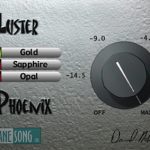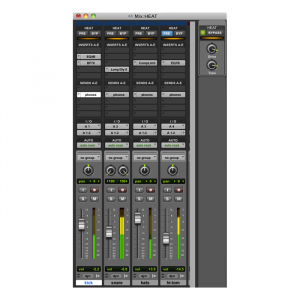HEAT is a new plug-in optional feature of Pro Tools HD 8.1. Unlike most plug-ins, it is built in the actual architecture of ProTools 8.1. It creates analog warmth in the box using what Avid calls Harmonically Enhanced Algorithm Technology. It was designed by Crane Song founder Dave Hill, a true genius in the audio world. HEAT is reminiscent of the Phoenix plug-in  and the amazing HEDD 192 harmonic enhancement device from Crane Song Limited. The difference with HEAT is that it works simultaneously across all channels in Pro Tools, giving the whole session a more analog-like quality. We recently released several videos demonstrating the power of HEAT. We listened to it on a classical piano track by artist/composer Ed McLean, a jazz tune by bassist/composer Alex Van Gils and recorded by the UNC Big Band, classical guitar, and a fusion track recorded by Scott Sawyer and members of The Old Ceremony. Check out our HEAT videos on our Youtube channel to hear the difference.
and the amazing HEDD 192 harmonic enhancement device from Crane Song Limited. The difference with HEAT is that it works simultaneously across all channels in Pro Tools, giving the whole session a more analog-like quality. We recently released several videos demonstrating the power of HEAT. We listened to it on a classical piano track by artist/composer Ed McLean, a jazz tune by bassist/composer Alex Van Gils and recorded by the UNC Big Band, classical guitar, and a fusion track recorded by Scott Sawyer and members of The Old Ceremony. Check out our HEAT videos on our Youtube channel to hear the difference.
In order to access HEAT, click on the view menu at the bottom left hand side of your mix window. You then see HEAT appear at the top of every audio channel. Moving to the options menu, you can scroll to the bottom and check the Activate Heat option. Then, by checking the arrow in the bottom right of the mix screen, you can view your universal HEAT controls.
 Heat has only two controls, Drive and Tone. The drive control emulates magnetic recording tape and harmonic distortion in analog gear. By turning the drive control counter-clockwise, it emulates tape-based linear distortion by adding odd harmonics. It adds a fatter sound to the low and midrange frequencies and smooths out the upper frequencies and transients. As the effect is increased, HEAT lights up, showing you when it is kicking in. The level of each channel affects the way that HEAT reacts to the audio. By moving the drive control clockwise, the effect is more aggressive by adding even harmonics found in analog tube gear along with the odd harmonics. In a tape-based analog system, high frequencies compress sooner than low frequencies. HEAT can make up for these losses by adding detail and higher frequencies back in the mix. Moving the Tone control clock-wise adds brightness, while moving it counter-clockwise removes the level of detail and brightness.
Heat has only two controls, Drive and Tone. The drive control emulates magnetic recording tape and harmonic distortion in analog gear. By turning the drive control counter-clockwise, it emulates tape-based linear distortion by adding odd harmonics. It adds a fatter sound to the low and midrange frequencies and smooths out the upper frequencies and transients. As the effect is increased, HEAT lights up, showing you when it is kicking in. The level of each channel affects the way that HEAT reacts to the audio. By moving the drive control clockwise, the effect is more aggressive by adding even harmonics found in analog tube gear along with the odd harmonics. In a tape-based analog system, high frequencies compress sooner than low frequencies. HEAT can make up for these losses by adding detail and higher frequencies back in the mix. Moving the Tone control clock-wise adds brightness, while moving it counter-clockwise removes the level of detail and brightness.

You can bypass HEAT on each individual channel, or bypass it altogether. You can also make every channel in HEAT pre or post fader. When the channels are post-fader, it affects the level of the signal that hits HEAT, making it more or less based upon the level of your fader. In pre-fader mode, the position of the fader has no effect on how it activates HEAT, it only depends on the level and frequency of the originally recorded material.
We will be using HEAT on just about every recording at our studio. It is simply incredible.

